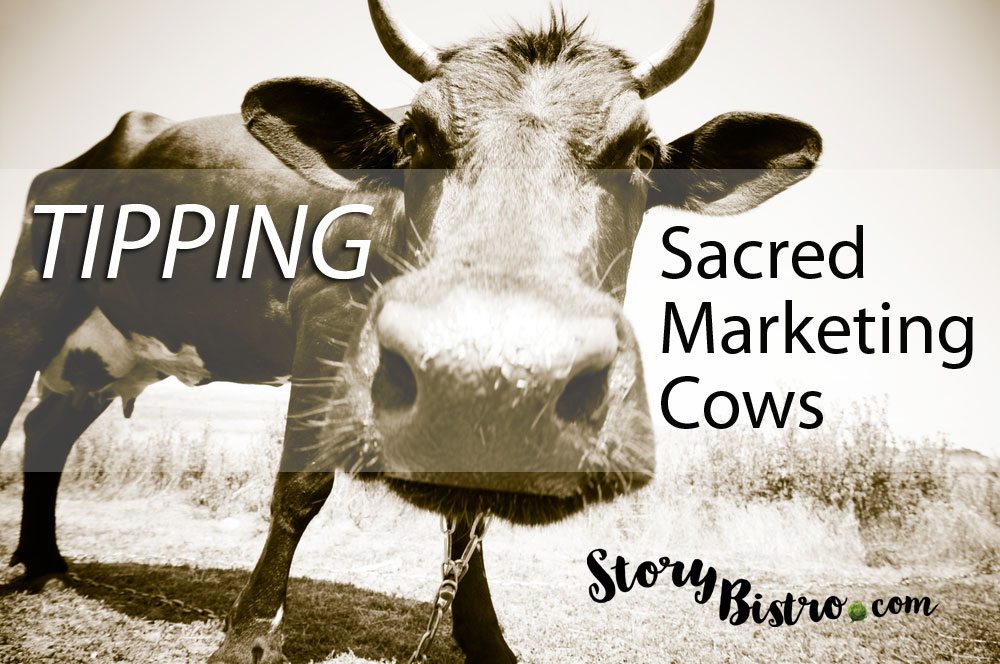Want to be different and stand out from the crowd? One of the best ways to do that is to challenge the status quo.
And over at the Business Luminaries’ Roundtable, that’s exactly what we’re doing.
Talking about the elephants in the various rooms of our industries. Tipping sacred cows. And in the process, we’re strengthening the power of our hearts and voices. Even me.
This week, let’s talk about the all-hallowed Elevator Pitch (and why I don’t believe 98% of the world needs one).
 My colleagues who know me well, are familiar with my view point on this topic.
My colleagues who know me well, are familiar with my view point on this topic.
So when Julia Sarver asked me to share my approach with her coaching group, I was happy to oblige. (She was also happy to let me share the recording with you.)
Below are the highlights of our conversation. If you’d like to listen to the whole thing (it’s just over an hour long), click play below:
Tea Godfrey: One of the things that you’ll hear a lot over and over again out in the business world is that you MUST have an elevator pitch. AND if you don’t have that elevator pitch down, you of course are not going to be successful.
I don’t agree. I say, ‘No. Please, let’s not do that anymore.’ It’s so much better if you can learn how to tell some stories about what you do and have conversations with real people.
Julia Sarver: Yes, everybody’s supposed to know how to say what they do in 20 seconds and it’s supposed to be perfect. The other person is supposed to be so wowed that they can’t wait to hear more. That’s a lot of pressure for a person meeting someone. In our industry, there are a number of people who offer a formula. When I used their formula of “I help _________ by ___________-ing so they can ______________ and then _____________.” (That’s literally the formula.) It didn’t help me. I just felt stupid.
I thought let’s have a real conversation about how we say what we do and how do we do it in a way where we can not feel cheesy, not feel the pressure that the other person is supposed to think that we’re so amazing or whatever afterward. Why can’t we do it in a way where it just feels a little more natural?
Tea: Right. So let’s talk about this. What do you folks like most about going to a networking event? When you go to a business party or a gathering of some sort, what is it that you enjoy most about that?
Audience Member: “Meeting new people.”
Tea: Yes, meeting new people and actual human beings who have something interesting to share, some kind of story. The connection is the fun part.
But the part where you feel like you’re having to sell yourself or be a pimp, so to speak, that is not fun at all. Like Julia says, it’s a lot of pressure to try and come with some prewritten script for what you’re going to say to people.
I would just ask you to think about, not throwing that all together because we certainly would like to be able to talk about what we do in a way that is thoughtful.
The thing that’s super important to remember about stories is that they need context. You guys have probably heard all of the wonderful marketing about why stories are important, why they’re important to use in your marketing — whether you’re giving a presentation or you are teaching something or you’re writing a blog post, right? We already know that stories work.
They work at helping you connect with other people. They work when you’re meeting people at a networking event. (Of course, we don’t want to be the hog and take up the whole conversation telling a long story. We want to make it a back and forth. This isn’t a one-sided, “I’m going to tell you a story,” because you need a listener and you need to tell her at the same time.) If you just remember that stories are really important and that’s the basis for where we’re going today, then the next piece will make so much sense.
It’s about the context. If you’re having a conversation with your grandmother, it’s going to be totally different than if you were having a conversation with a potential client. That’s why the elevator pitch just doesn’t work because it doesn’t take into account all of the different contextual places that you may be showing up.
Here’s how I do it. This is my little trick. I always like to get the other person to talk first so that I can get a handle on who they are and what our shared context is. What their goals are. It really helps me have a better conversation if I know who I’m talking to. If you get that opportunity to say to somebody new first, “Hey, what are you doing when you’re not hanging out here at this fabulous business networking event?” Then, they will tell you a little bit about themselves first. And then, they’ll naturally ask you what you do. That gives you the nice little opening to talk about that.
Julia: That’s like a super ninja trick.
Tea: Totally. Especially if you’re introverted at all, it really takes the pressure off.
Julia: I have no doubts because when you presented to our group last time, everybody loved it and got so many great action items from it. Julie just popped up another note. She says, “I offer two different services that can either blend or be independent. It can be challenging to express how they work together without being overly explanatory.” If we can potentially address that too, that would be really great.
Tea: Here’s the secret, Julie. The secret is: you don’t have to tell your whole story in one meeting.
Julia: I love that secret.
Tea: You are off the hook. See, the thing that gets people hung up is they feel like, “Oh, well I have these three different services and I need to talk about all of them succinctly in one conversation.”
You don’t have to do that. In fact, I would say it’s like dating. You don’t want to give away the whole story right up front. Save a little bit and be mysterious and have another conversation. You can allude to the fact that you do other things. If the situation is right and the person seems truly interested and wants to hear about the rest, then you could go there but don’t feel like you have to try and offer the whole enchilada with everything. It doesn’t work that way.
Before we go further, let’s briefly look at what a story IS. When I’m helping my clients add engaging stories to their content, the first thing that I have to get through to them is that it’s about showing, not telling. It’s the difference between answering, “What do you do?” with “I’m a bookkeeper.” And answering, “What do you do?” with, “I take business people’s invoices and process them for payment.”
You’ve basically told them a story about what you do versus just naming it. Do you see the distinction there? Granted that wasn’t a very interesting description of being a bookkeeper but what I’m trying to get through is that we don’t necessarily want to just tell somebody, “I am a health coach,” or, “I am a marketing coach,” because that doesn’t really paint a picture for anybody. Nobody, unless they are a health coach, is going to understand truly what it is you do unless you talk about it in a way that invites people into an experience.
The other piece that’s really crucial to storytelling is including the emotion, emotional words are those that have to do with feeling.
If you are tapped into what your potential clients are feeling about the challenges they’re having and you include that language in whatever conversation you’re have, you’re going to invite a listener to that experience in a better way, in a deeper way.
If I tell you I’m a storytelling coach or I tell you I am a marketing coach, that’s telling. If I show you what I do, then I would say something like, “You know how when you’re running a business and you get really worried about the ick factor of marketing yourself and you really don’t want to do any of it? Well, I teach my clients how to tell the stories that are already there so that it just becomes a conversation instead of this whole preconceived strategy thing that they have to carry out.”
That’s just one off-the-cuff way that I could describe what I do in a storytelling way. I gave you a little tiny bit of emotion in there. Hint: it was when I mentioned the ick factor of marketing.
What you want to do is you want to find the emotion that your potential client is feeling about the thing that you help them with.
Here’s my starter recipe. It has five ingredients. If you answer these five questions, you can create anything. You can use this for writing a blog post. You can use it for writing a sales page, an e-mail, a presentation. But most especially — for our purposes here — you can use them to build a great conversation with someone new.
Let’s go through them one at a time.
1. What is the problem that you solve for your client?
Now, here’s where people get stuck. They’re like, “Oh, well, I solve like 12 problems.”
Yes, okay. Write 12 different blog posts about it but when you’re having a conversation with somebody, you want to pick one.
When I talked about one problem just a minute ago about me being a marketing coach in the clients I work with, the problem I picked was having an aversion to marketing or feeling that ick factor about marketing. I’m talking to people whose problem is, “I don’t like marketing. Marketing makes me feel bad about myself. It makes me feel like I have to put pressure on people. I don’t want to be a used car salesman.” There’s all of that wrapped up in there. That’s just one problem. That’s not all the problems I solve but it’s one way for me to talk about it.
2. Why hasn’t the problem been solved yet?
The problem is x. There’s a reason why that problem hasn’t been solved yet or that desire hasn’t been fulfilled yet.
A lot of times, the reason it hasn’t been fixed is because the person doesn’t know how to fix it. They may have tried a few things and gotten frustrated and given up but still the reason is they just don’t know how to address it properly.
It also could be that they haven’t had the money or that they’re getting pressure from family and friends to do something differently.
You know better what the reason is for why that problem hasn’t been fixed yet.
For me, the reason why people aren’t as successful with their marketing as they could be is because of that same problem which is, “I don’t like marketing. It makes me feel icky.” I have to help them get over that. I have to help them get over the ick factor. To enjoy the process by reframing it as something other than marketing. (Like sharing stories, instead.)
3. What’s possible once the problem is solved?
What is the perfect world vision of what could happen for that person?
For me, it would be: “If you can get over the ick factor, marketing can be fun. Marketing (and even sales) can be like having a fun conversation with a new friend and NOT worrying about whether or not you’re going to make a sales call.
4. Why are you particularly suited to help people with that problem?
Why are you specifically and uniquely qualified to do the work you do? What makes you different?
5. The invitation or call to action.
Lastly, you want to invite them to something. Now, in traditional marketing parlance we call that ‘the CTA’ or the call to action.
I like to call it the call to adventure because that’s more in line with storytelling. But really … If you look at it as if you’re inviting somebody to have fun with you, it’s so much more easy to go there than to be like, “Are you ready to give me your money now?”
Julia: That is so funny. Have you actually ended a conversation like that? Are you ready to give me your money?
Tea: I haven’t but I’ve seen other people do it.
Julia: I think that’s what gives marketing a bad name because we all feel weird asking for the money. That part, when you’re not clear about what you’re doing, you don’t know how to talk about what you’re doing and then all of a sudden, “Give me money because I know I can help you but I’m not really sure how to explain it.” This is why I’m so glad that we’re talking with you today because I think that’s a key piece of it. I love it being a call to adventure because who doesn’t want to go on an adventure?
Tea: I know, right? Your call to adventure could be, “Let’s have coffee and talk about it.” That’s easy.
Julia: That is easy. I think that’s one of the things that happens not only in our industry, specifically in the health coaches’ world but also in a lot of online is that it’s like if you don’t make the sale immediately, then that means you haven’t explained yourself well enough or whatever it is. I really feel like maybe there’s something going on that you don’t know about or maybe it’s just a person who likes to think for a few minutes before they make a decision about where they’re going to invest. I think there’s a lot of pressure in terms of having these conversations about what you do. It feels like we’re supposed to be getting a sale anytime we talk about what we do. That’s not actually accurate.
Tea: It’s not. And I have a great story to illustrate this.
When I first moved to Portland, I was attending, as one does, various different meet-up groups to try and meet new people and see if I could find my tribe.
During the course of that, I met a woman who was selling LegalShield. The presentation intrigued me and I was in a place where I was just recently married and had a new house and all of these legal things needed to happen. It was a right time for me to say, “I would like to talk to you.” I asked her to e-mail me.
Now, here is the important thing. Listen so carefully to what people say to you. I asked her to e-mail me …
Julia: What did she do?
Tea: I gave her my business card and she called me.
Now, my business is set up in such a way that I will not answer the phone usually unless we have an appointment or I can see on my caller ID that it’s somebody I needed to talk to right away. But she called me. She left a message. I replied back via an e-mail to her. “Please set up an appointment on my calendar so that we can talk because that’s how I like to do it.”
She called me again. That time I picked up the phone. I was straight with her. I said, “Look, I’ve been really upset because you didn’t listen to me and this is the way I work and I need you to e-mail me and set up an appointment on my calendar because I’m very busy and I don’t have time right now to listen to a sales pitch.” She was like, “I’m sorry. I just don’t do electronics.”
Julia: Wow. When was it, like 2014?
Tea: Yeah.
This is why context is so important and why listening is so crucial. You’ve got to hear what somebody is saying they want and need and where they are.
Those five ingredients are not necessarily all going to be given in a conversation with somebody. You have to listen and see if it’s even right.
You’re not going to make an invitation to somebody unless you’re getting a signal that they’re saying, “Yeah, I want to learn more from you. Let’s do this.” That’s part of it. You’re not going to talk about yourself and why you are uniquely suited to solve their problem unless they ask you, “How did you get into this?” If they indicate they want to know your back story, great. If they don’t ask you, don’t offer it. It’s as simple as that. This isn’t a, five steps to closing the sale. This is a, these are the things that you can watch for and see if there’s a fit.
These five ingredients are really good. And it’s a good rule of thumb if you’re writing a blog post or you’re writing a sales page for your website to use them all. But that’s a totally different context from being in a room with somebody.
Julia: Should we do some workshopping? Is that what our next step is?
Tea: I think so, yes.
Julia: Julie, are you still okay with being our first volunteer?
Julie: Hello.
Tea: Julie, I want you to think about the last client that you really loved working with and what the problem was and then very succinctly, like in one or two sentences tell me how you’ve helped that person get through or get over that.
Julie: Okay.
Tea: So I say “Hello. Nice to meet you. What do you do when you’re not here?”
Julie: “I work with people to extract what they’re holding in their bodies and their hearts. I help them bring that forward so they can move forward in their life.” That did not even come out right. I know it.
Tea: Julie, tell me about just the last client. Just tell me about the client.
Julie: My last client works with people who are dying. Her deep, down heart space was asking for her own personal care. Basically, I extract that what people are not wanting to confront but they know they need to, their body holds it, I feel it, hear it, and we address it and find solutions.
Tea: Let’s talk like normal human beings now and not life coach-y folks because this is really where things get muddled. You are working with this person who has this really sensitive thing going on. Is this a lady or a man? Is this a lady?
Julie: Woman.
Tea: She’s working with people who are dying. Now, you’re not going to say, “You know how when you’re working with someone who’s dying and …” That’s too sensitive and not appropriate here. This is where you would ask something like, “Have you ever known anyone who worked with a really vulnerable population like maybe in a hospice?”
We’re using your last favorite client as the model for this storytelling conversation. We’re getting the setting here.
“Have you ever known anyone who works with a really vulnerable population like in a hospice?”
Then, your conversation partner responds with something like, “Yeah, you know, my sister used to do that.”
You’d say, “Well, when they’re doing that kind of work, they can tend to shut off their emotions so that they can deal with all that heaviness on a daily basis.”
And your partner would say, “Yeah, she did that. She got really good at that.”
And you respond with, “Well, I sit down with folks like that and help them break down all of those walls and figure out what it is they’ve not been looking at or hiding from and then we work through it together.”
Then, he would say something like, “Really? How do you do that?”
And now you’re having this conversation about what you do. You’re NOT using words like, “I extract it.” That sounds like you’re a dentist.
Julie: Right. It’s funny because I use those words every day, that type of vocabulary often. That’s interesting to hear that perspective because perhaps, my mind subconsciously automatically goes into some form of a coaching mode or healer mode. To bridge that gap and find a comfortable piece that’s me that’s still explaining or speaking, that is something I will need to take a little note of.
Tea: There’s a trick that a lot of marketing people use and that is to think about how you’d explain it to somebody who’s seven years old. A seven-year-old is going to have a totally different vocabulary.
This problem isn’t just you, Julie. This happens to almost everybody. It’s called jargon.
What we want to do is we want to get away from jargon. We want to talk in as basic language as we can to help people understand the process of how we work with people. Does that make sense? Do you think you could have a conversation like that if you were at an event somewhere?
Julie: Yeah, I really do. That particular sentence and concept absolutely simplifies the whole management in my head. I really appreciate that. That was good.
Tea: You’re welcome. If you ask the question like, “Have you ever known anyone who worked in a hospice situation or worked with a vulnerable population,” and they say no, then you can still continue with the conversation and still say, “Well, this is what I do.” It’s just that if you let them imagine who they know first — whether it’s a friend or a family member or a co-worker or whatever — then you’re really going to have a richer conversation. They’ll be able to relate. They’d be like, “Yeah, I know. The only way I could deal with it was to just turn off all my emotions and not…”
Julie: I will definitely need to give that consideration as far as how I phrase things, word things and even on my website. That right there gives me pause, kind of like, wow, this is such a … not cold but it’s, where’s the warmth and personalization. That is something to take a look at.
Tea: It’s much more effective when you can be specific to a particular situation or a particular character than it is to say, “On a broad stroke, I do this general thing with all of these people.” If you can really just focus your mind on writing a page just for one type of person, you will find it easier to get a first draft out that has the much better language. Then, if you can have somebody who’s not in your field read it and see if they understand what you’re saying. Then, that’s really helpful.
Julie: I have a quick question. Using my own language and now that we’ve got the seven-year-old picture that just makes it easier, really I would almost liken it to the fact that when you’re … I think this can go any age but really, it’s like when you’re holding onto an emotion, when you’re stuck so if you’re seven and somebody took your toy and you can’t get over that feeling of wanting it back and it just festers on the inside of your body, I don’t know. It’s …
Tea: That explanation makes it so much easier for me to understand what you’re doing because when you said “extract,” I wondered whether you’re doing some kind of psychic surgery or something. What is the ‘extraction’ process? Are you talking something through with people? Are you doing hands-on healing? Are you doing a combination? All of those things need to be spelled out. Otherwise, people are going to look at you and they’re eyes will glaze over.
Julia: I love it. Thank you for being willing, Julie.
There’s a whole lot more to this conversation and we walked through this process with another volunteer. Listen to the recording here, or see below to download the full transcript.










Twitter: LindaUrsin
on February 14, 2016 at 8:20 am
I would love to be able to use that kind of intro instead of the stiff one on social media profiles too 🙂
Yes! Use it everywhere. xo
Twitter: LindaUrsin
on February 14, 2016 at 8:30 am
I just have to figure out how to get it down to 140 characters 🙂
Ah, but see, it’s really just the opening that you need to get down to 140 characters. The invitation to a conversation doesn’t need to hold the entire conversation within it.
Twitter: LindaUrsin
on February 14, 2016 at 8:48 am
Thanks 🙂
Twitter: grovecanada
on December 5, 2016 at 1:56 am
I have the people calling thing when I ask for email hang up too…( Sorry for labelling it a hang up- on my end, it is clients, so I tend to blame myself for not being more forgiving about tech phobias)…ps.I am still slowing down to speed up! ( recently started reading paper again! -as opposed to digitally…)
Go Sari!
Téa Silvestre Godfrey recently posted…Tipping Sacred Marketing Cows: The Hero’s Journey as Ideal Story Structure